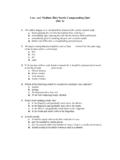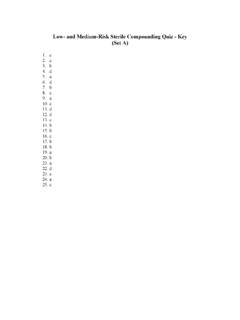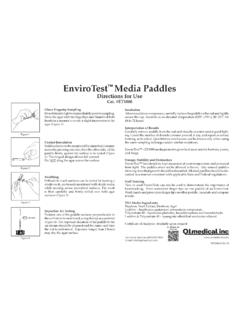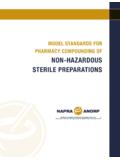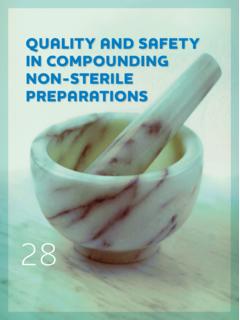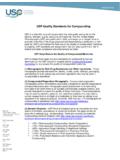Transcription of High-Risk Sterility Quiz - QI Medical, Inc.
1 High-Risk sterile Compounding quiz 1. Compounding personnel involved with High-Risk sterile compounding should pass a written test and perform a media-fill challenge test at least a. monthly. b. semi-annually. c. annually. d. bi-monthly. 2. Measuring and mixing sterile ingredients in non- sterile devices before sterilization is performed is an example of a. low-risk compounding. b. medium-risk compounding. c. High-Risk compounding. d. ultimate-risk compounding. 3. All High-Risk level compounded sterile preparations, except for inhalation and ophthalmic administration, that are prepared in groups of more than 25 identical individual single-dose packages or in multi-dose vials for administration to multiple patients must be tested for Sterility and excessive bacterial endotoxins.
2 A. True b. False 4. Sterilization of High-Risk level compounded sterile preparations by _____ is the preferred method to terminally sterilize aqueous preparations that have been verified to maintain their full chemical and physical stability under the conditions employed. a. filtration b. autoclave c. dry heat d. irradiation 5. For sterile compounding areas used for High-Risk preparations, environmental monitoring for viable airborne microorganisms should be done at least a. weekly. b. monthly. c. semi-annually. d. annually. 6. Buffer or clean room area in which the laminar airflow workbench is located must provide at least _____ air quality. a. ISO Class 5 b. ISO Class 6 c. ISO Class 7 d. ISO Class 8 7. While weighing and mixing nonsterile ingredients for a High-Risk level preparation, compounding personnel shall be garbed and gloved the same as when performing compounding in an ISO Class 5 environment.
3 A. True b. False 8. Risk levels of CSPs are assigned according to a. chemical stability of CSPs. b. storage conditions of CSPs. c. contamination probability of CSPs. d. beyond-use dating of CSPs. 9. If no Sterility testing is performed on a High-Risk compounded sterile preparation, a beyond-use date of _____ must be assigned. a. 48 hours at room temperature b. 7 days refrigerated c. 30 hours at room temperature d. 3 days refrigerated 10. Pushing a non- sterile solution through a ____ micron filter will sterilize the solution. a. 5 b. c. d. 11. Compounding total parenteral nutrition fluids with commercially available sterile products using manual or automated devices is an example of a. low risk.
4 B. medium risk. c. high risk. d. ultimate risk. 12. The preferred method to terminally sterilize an anhydrous High-Risk level preparation is _____. a. autoclaving b. filtering c. radiation d. dry heat 13. A barrier isolator a. must be located in an ISO Class 8 clean room. b. may be used for High-Risk and hazardous sterile compounding only. c. shall be placed within a buffer area away from opened doors or high -traffic areas. d. none of the above 14. _____ may be re-used for high risk compounding if removed and retained in the compounding area, but only during the same shift. a. Hair covers b.
5 Shoe covers c. Gowns d. none of the above 15. The method of choice for Sterility testing of high risk sterile preparations is a. membrane filtration method. b. direct inoculation of culture medium. c. HPLC. d. TLC. 16. High-Risk level sterile preparations may be dispensed before receiving the results of their Sterility tests if a. there is a written procedure requiring daily observation of the incubating test specimens. b. there is a written procedure for immediate recall of the dispensed preparation when there is evidence of microbial growth. c. both a and b are done d. there is written consent by both the patient and prescribing physician.
6 17. Non- sterile components used to compound high risk sterile preparations a. should preferably be USP or NF grade quality. b. shall be accompanied by certificates of analysis. c. must be FDA-approved for the intended use. d. only a and b e. all of the above 18. The selection of indicators and the effectiveness of the overall Quality Assurance plan is reassessed on a(n) a. monthly basis. b. semi-annual basis. c. annual basis. d. quarterly basis. 19. Gloved fingertip sampling is performed a. immediately following the compounding and sterilization of a High-Risk level CSP. b. immediately following the hand hygiene and garbing procedure.
7 C. annually for High-Risk level compounding personnel. d. weekly for High-Risk level compounding personnel. 20. compounded sterile products must be double-checked for accuracy only if a technician is the primary compounder. a. True b. False 21. All High-Risk level CSP solutions subjected to terminal sterilization are prefiltered by passing through a filter with a nominal pore size not larger than _____ microns preceding or during filling into their final containers. a. b. c. d. 5 22. Immediate-use CSPs are considered High-Risk level CSPs because they may be compounded in and exposed to air quality worse than ISO Class 5.
8 A. True b. False 23. _____ are considered High-Risk level sterile compounding because the compounder is exposed to potentially harmful materials. a. Hazardous drugs b. Radiopharmaceuticals c. Allergen extracts d. All of the above e. None of the above 24. Glass and metal devices may be depyrogenated and sterilized by a. covering them tightly in aluminum foil, then exposing them to dry heat in an oven at a mean temperature of 250 for 30 minutes. b. placing them in a sealed pouch and autoclaving them at 121 under 15 psi for 20 to 60 minutes. c. placing them in a sealed pouch and irradiating them with gamma rays for 15 minutes.
9 D. placing them in a sealed pouch and sending them to an outsourced contractor to be sterilized and depyrogenated utilizing ethylene oxide gas. 25. Viable air sampling shall be performed a. in the critical area only. b. in the buffer room only. c. in locations prone to contamination during compounding activities. d. in the primary engineering control (PEC).
